I tin can honestly aspect the apply of point and figure charts as ane of the turning points in my trading career. Earlier on as I studied the works of Richard Wyckoff, point and effigy (P&F) charts were a staple of his trading methodology.
Every bit I began to define and refine my own trading systems, I slowly drifted abroad from P&F for more than sexy analysis techniques such equally Elliott Wave and candlestick patterns.
I soon realized that while these other analysis methods made me experience sophisticated, it wasn’t adding much in terms of coin to my account. Every bit I continued to refine my trading methodology, oddly enough I landed dorsum where I started – P&F charts.
Across the web you will find a number of articles and books on how to create P&F targets. Yet, what I aim to do in this commodity is to not simply give you the mechanics for how to perform a count, but to show you my exact settings for determining a turn a profit target. I will also provide real-life examples so you tin can meet things in action.
Why perform P&F counts
I am a firm believer that the market will practise any it wants to. Then, information technology begs the question, why would I get in the business of attempting to predict or guesstimate where the marketplace is headed?
The elementary respond to this question is that I seek to sympathise how far a stock tin run for the footing of calculating my gamble versus advantage for every trade I take on. This provides me the means to see before I enter a merchandise whether the stock fits the criteria of my risk profile.
Where people get in problem with targets (P&F, Elliott Wave, Gann, etc.) is when the trader begins to believe that the market must conform to his or her analysis. I have personally seen this lack of flexibility ruin otherwise would exist peachy traders.
Methods for calculating P&F Targets
There are two primary methods for calculating P&F targets: (one) vertical and (2) horizontal. I will non be covering horizontal counts in this article because over time I take found this method unreliable.
Reason existence when you take a meaning consolidation range, determining which level and how many boxes to count can exist challenging. While there are methods out there for properly determining which row to count, for me these methods lend themselves to too much subjectivity.
For an case of a horizontal count, below is 1-box P&F chart of the stock Rockwell Medical Technologies, Inc. (RMTI).
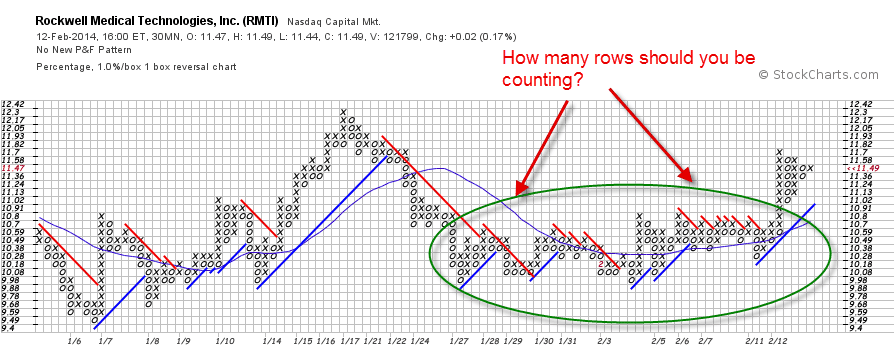
Where would you have made your horizontal count?
Now, allow’s await at the aforementioned chart, but on a 3-point reversal.
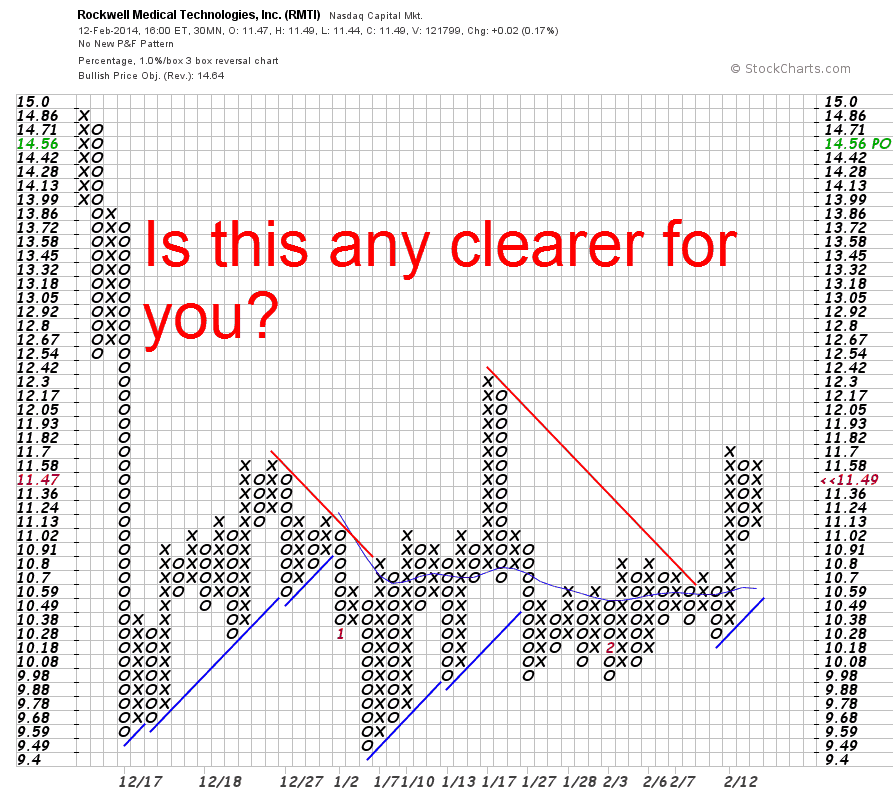
I don’t know about y’all, but that doesn’t give me the warm and fuzzies either. At present, let’southward utilize a vertical count to the aforementioned 3-signal nautical chart instead of horizontal.
We showtime identify the depression of the nautical chart which is $9.49 and we count the next column of x’s. The next column has a total of 13x’s. To find the P&F target, we accept xiii ten 3 (think we are on a iii point nautical chart) which gives usa a total of 39. Nosotros then count up 39 boxes from $9.49 to go far at a cost target of $thirteen.86.
With this additional level of clarity, let’s go back and look at the previous chart example to illustrate the count.
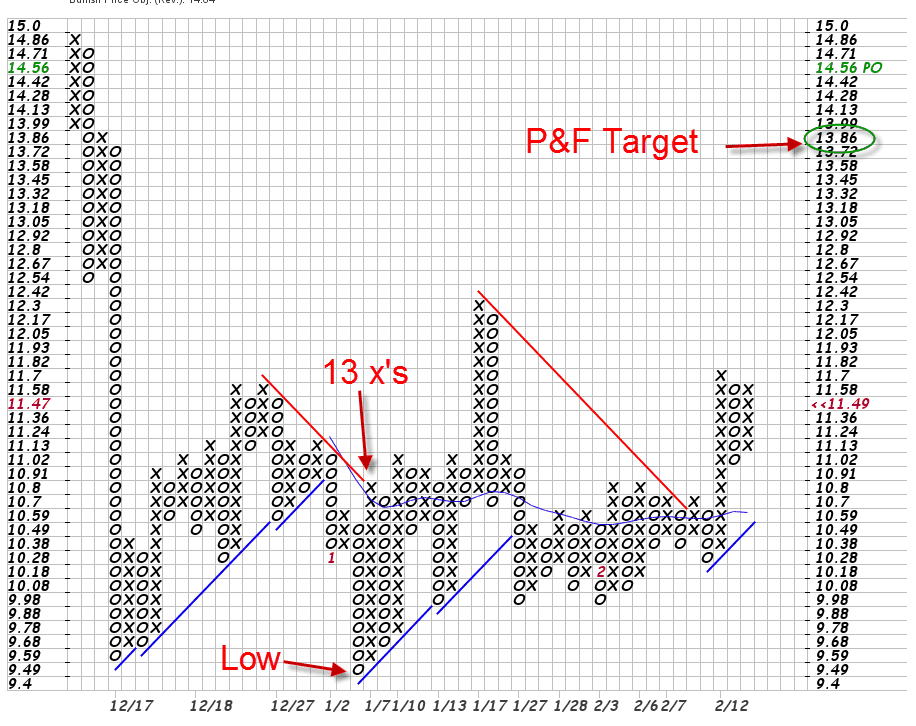
Simple as pie right? I am existence facetious, but on some level it really is only that unproblematic. Y’all detect the low or loftier of a major swing. Yous then look to the next column of x’s or o’s and take that count times 3 to get your target from the swing point.
This to me is much simpler than trying to have horizontal P&F counts or worst trying to determine what sub-wave nosotros are in of an Elliott Wave pattern.
My Specific P&F Configuration Settings
Those of you familiar with P&F counts are probably saying to yourself, well great job numbnuts, y’all managed to explicate vertical P&F counts.
Y’all would exist right in this statement, and then let me take information technology a step further and give you lot my exact configuration.
(i) Number of P&F boxes
- Every bit stated earlier in the commodity, I use a box count of 3 to reduce the level of clutter on the chart.
(two) Vertical Count
- The vertical count reduces the level of subjectivity and provides a clear column of boxes to make up one’s mind a count.
- Vertical counts also reduce the potential for counting also many boxes horizontally, which will produce unrealistic P&F targets.
(iii) Scale
- I use the percent scale and more specifically 1% boxes. This is a critical factor for nailing the precision of a target. I previously used the traditional scale, which prescribes a set number of boxes for toll levels. This means that the P&F vertical will increment in fixed increments (.25, .five, 1) until a new high or low is breached ($10, $100) and then the count moves to the next increment level up.
The reason I like percentages, is because it takes into account the price movement at each box levels versus fundamental price levels where the increments increase. Timeframe
- I wait at the thirty-minute timeframe for my P&F charts. Intraday P&F charts are not the same actually equally candlesticks or bar charts. The charts themselves remove time from the equation, so really all we are doing is capturing more than price moves throughout the twenty-four hours, versus using a daily timeframe where just a few price inputs are used to calculate the P&F. The one-time school method of using P&F was based on using tick charts, but for the purposes of my assay, 30-minute gives me the perfect mix of staying close to the price activeness, without overloading myself with fresh data.
For the well-nigh part numbers 1 through three should exist pretty common; however, number four is where I split up myself from the pack. The cardinal inputs of using a scaling method of percentages and the timeframe of 30 minutes volition provide you a level of clarity on the market place similar to the commencement fourth dimension you put on a pair of spectacles (bold you own a pair).
Real-life examples
Now that we have covered how to develop P&F counts in theory, permit’s await at some real-life examples.
RMTI Long Position
Going back to the RMTI position, I entered the trade at $10.17 on 2/5/2014. From in that location, RMTI went flat for a period of time working through its consolidation stage. Once the stock began to take off, I knew that all roads would point to ~$13.86 based on the P&F count.
Below is a chart of how the price activity ultimately played out.
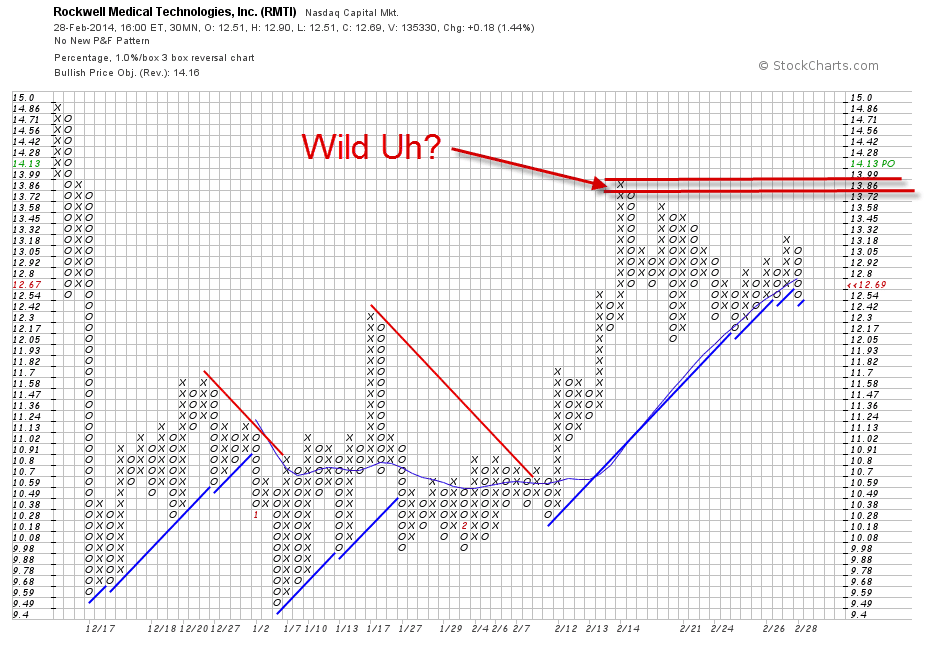
I was able to close the stock out slightly beneath the P&F target for a 30+% gain on ii/14/2014.
I use to worry about why things happened and needed to know every unmarried item. I have reached a maturity level now where bluntly I no longer care. Call it luck; call it divine intervention, P&F targets simply work.
I shouldn’t be so flipid; P&F targets are the upshot of the battle between supply and demand at key congestion zones. Once the price is able to leave these consolidation formations, the box count provides the resulting target for the move.
HWAY Curt Position
HWAY took me for a bit of a ride. I placed the short trade on 12/26/2013. Looking back I was hungry for activeness while I was on vacation and I had no business placing the merchandise as the market was in full vacation mode.
Needless to say, HWAY went well above my entry point of $15.43 and drifted due north of $17. This process of letting HWAY tire out the longs would take been unbearable if it weren’t for my trusty P&F count.
One picayune ace up my sleeve was the P&F target for HWAY was $xvi.91. Delight see the count in the below chart:
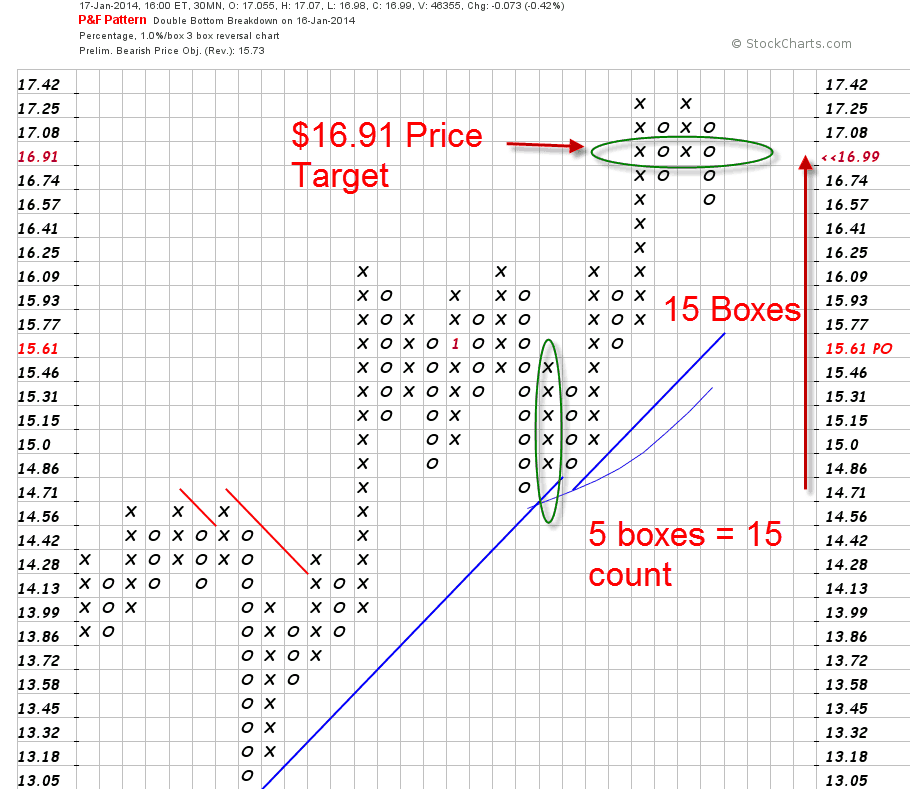
And so, y’all may be request how did I know $16.91 was the target? I knew this for a couple of reasons:
(1) The P&F target from the $13.05 depression was met ($15.93), so the next target would be the count coming out of the trading range.
(2) $14.71 was the low of the consolidation range. From this low there was a 5-box vertical count on a iii indicate nautical chart up to $16.91.
I knew with a high degree of conviction that HWAY would confront pregnant resistance at $xvi.91. As you can see from the chart, HWAY actually exceeded the P&F count slightly, only to later rollover.
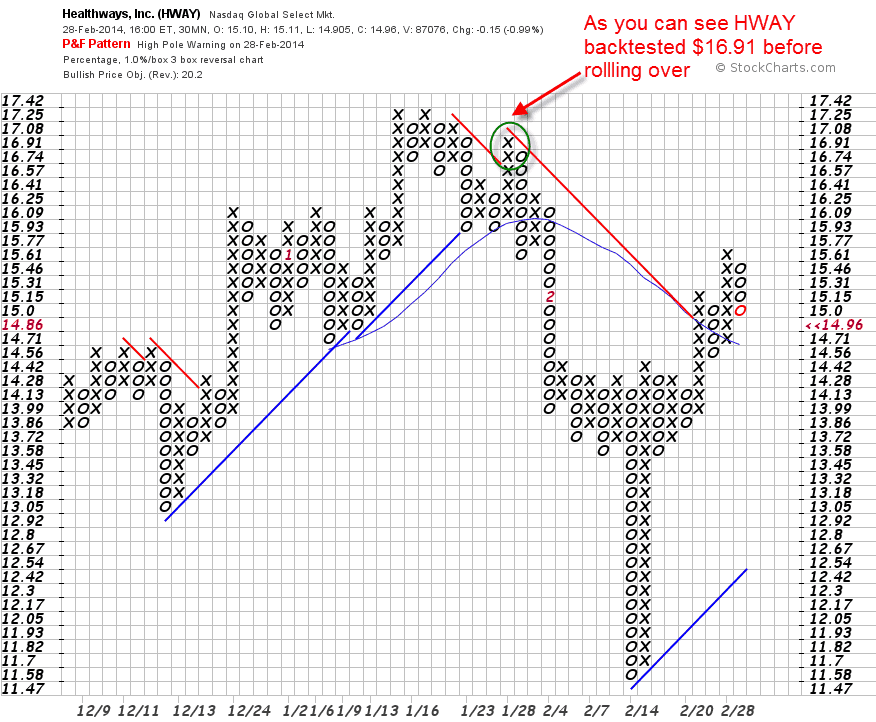
Without knowing the potential reversal zone at $16.91, I would have had a tough fourth dimension sitting through the position every bit the stock initially moved against me.
Pros of P&F Counts
- Provides you a roadmap for where a market or stock is likely headed.
- Serves as an alert to pay closer attention to your positions as central levels are hit.
- Helps determine take chances advantage parameters.
Cons of P&F Counts
- The counts are “targets”, remember the marketplace tin can always go higher or lower.
- When determining counts, expect back to see how closely a stock has met these target levels. If the stock has overshot targets in the past, it will likely practise so in the future.
- You have to command the urge to find counts on multiple timeframes. This will cause analysis paralysis to set in. But use 1 timeframe to ensure you do not deject the technical picture.
In Conclusion
The P&F settings discussed in this article are specific to my swing trading organization. By using these settings I am able to achieve anywhere from x% – 40% gains when taking into account my trade management strategy which calls for me to permit my winners run.
As you explore the possibility of using P&F charts to determine price targets you lot will desire to have the following into account:
(1) Are you swing trading, day trading or long-term investing?
(2) What is the volatility of the stocks yous are trading? This will straight impact the validity of the P&F targets.
Continue to tweak your P& parameters until you observe a system that gives yous the almost profit on every merchandise.
Source: https://www.tradingsim.com/day-trading/how-to-calculate-point-and-figure-price-targets-when-swing-trading







